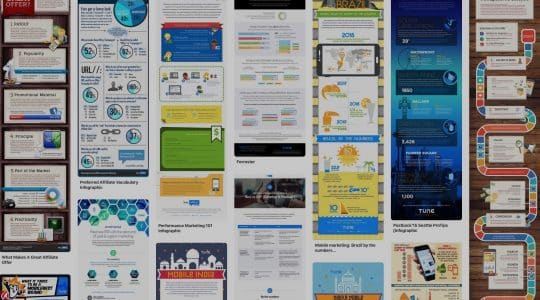
Small business owners wear a lot of hats to keep their operations running. Oftentimes, tackling marketing feels like the hardest task, and can end up on the back burner. But tackling marketing effectively can be a huge driver for business growth.
Mobile marketing may seem intimidating or difficult, but it doesn’t have to be. By knowing a few simple tricks and applying an understanding of your customer, you can grow your business, gain a competitive advantage and wow your friends. Here’s how.
First, some marketing basics
Digital marketing allows business owners to sell their products or services through various forms of digital media, which are called “channels.” These channels include email promotion, paid search ads, social media like Facebook and Instagram, affiliate marketing, and many more.
You may already be using an email marketing service to send announcements and newsletters to your customers, posting updates and photos to social media, or monitoring feedback on Yelp and other ratings sites. If so, congrats! You’re already covering some basics.
Digital marketing can target potential customers with ads when they are online or on their mobile phone. A few digital advertisements can be a highly effective way to grow your business because it is scalable and trackable, meaning you can see who is getting your ads, who is clicking them, and who is spending money on your business.
Mobile marketing includes a variety of ways to interact with people on their mobile devices like phones and tablets, which is where people are increasingly spending their time. This includes delivering ads on mobile web browsers like Google and Safari or through mobile apps like Facebook and Candy Crush, and optimizing your website so it is easy to use by people on their phones, among other things.
Consider these mobile marketing starting steps from Social Media Examiner:
- Be sure to have a mobile-optimized website. A mobile website takes all the content from your existing website and formats it for a mobile screen. All the text from your website becomes larger and buttons become clickable without having to zoom in. Some content management systems powering your website will have this code built in. If not, you will want to consult a web developer or evaluate software that can provide this.
- Identify your business on location-based mediums. Claiming your business on social sites like Facebook, Yelp and Foursquare allows you to serve ads as that business and people can “check in” when they are at your establishment. Claiming your business is like “calling up the phone company to get a free listing in Yellow Pages.”
- Get help to design creative assets for ads. Creative assets are the designs for your ads. If creating good ones is likely outside your creative or technical capacity, you can find inexpensive freelancers or contractors. Make sure the writing (called copy) on them is clear and concise. If you have a sale, make the discount code or percentage saved big and easy to read.
Set a concrete budget
Determining how much to spend on marketing can be daunting. You don’t want to waste money. You also don’t want to go over budget. Where to start?
First, realize that marketing is an investment, but one that, done right, should make you more money in the long-term. You’ll want budget to align to goals. Start with asking the right questions to determine the appropriate spend.
Forbes has great questions to ask yourself when budget setting as a small business, like:
- What are your needs?
- What are you currently paying to play?
- How fast fast you afford to grow?
- Are you able to take the risk?
- How do you minimize your risk?
Then, determine what channels you want to explore. For many small businesses, starting somewhere with low-cost advertising like Facebook ads is a good idea.
[bctt tweet=”For many small businesses, starting somewhere with low-cost advertising like Facebook ads is a good idea.” username=”tune”]If you are already spending money on getting new customers, that’s great. Determine how much you are spending per week or month and decide how much you’d like to spend per new customer.
Then comes the math. Your revenue needs to be greater than your advertising budget. If you run a Facebook ad for users to buy necklaces on your website and spend $100 on it, you should see revenue of at least $101 (and hopefully much more!) Hubspot has a great step-by-step guide on how to run ads on Facebook, including more budget info.
Small businesses should start local
Location-based marketing is a mobile marketing approach that allows you to market to people within a certain geographic area. This gives brick-and-mortar businesses the ability to identify customers within a specific radius that may be interested in their product. With this technology they can deliver ads on their phone while they are near their store.
If your business sells sporting goods, you could use location-based marketing at the stadium or community parks to serve up an ad when athletics are on their mind. Rent kayaks? Zero in on people near the beach with an ad on their mobile phone. Have a coffee shop? Attract people within a mile of you with a coupon to get them in the door.
If location-based marketing is more than you want to tackle, consider basic text message promotions. Leveraging SMS (short messaging service, or text communications) campaigns are still relevant and users can easily opt out of them.
“Do you know SMS coupons enjoy a stunning 10 times higher redemption rates compared to their print variables?” Everypost notes. “You can easily lose such coupons issued in the Sunday paper while losing them on your smartphone is literally impossible. Moreover, SMS marketing just because of hitting the personal device like a smartphone can actually address customers more personally.”
Use SEO to your advantage
Search engine optimization, or SEO, refers to the process of getting people to find your company online, like searching on Google. One way to do this is to pay Google money and “bid” on specific keywords that people may plug into a browser when looking for your company, products or services. Bidding for a keyword means paying Google to buy a keyword that relates to your business and in return you get traffic on Google’s search engine. This helps customers find your business and your website appears higher in search results.
Search engine optimization can seem tough when competing against huge corporations, but using tactics like long tail keywords can actually work to your advantage. Long tail keywords are three or four word phrases that provide greater specificity to what you are selling, as opposed to shorter more general words that tend to be more competitive and harder to rank high in.
For instance, a keyword promoting a tennis equipment shop could be “tennis racquets” and a long tail keyword would be “tennis racquets restringing Seattle.” If you bid on this long tail keyword, users in Seattle who want to buy a tennis racquet or get theirs restrung will find your business instead of a large corporation like Wilson.
Long tail keywords receive less traffic (people who search for that term), and that usually means those people are more likely to click on your ad or website because they are looking for something more specific.
You may be the car dealership for people with bad credit or have the best support services. Small Business Trends suggests using using these niches in your SEO in the form long tail keywords to beat out bigger companies. For instance “car dealership free pickup” is much more specific than “car dealership.” Long-tail keywords are cheaper to bid on find a more niche audience that is specifically looking for your product or services.
You can’t do everything, and that’s OK
As a small business, aim for quality over quantity. When starting out, don’t try to do it all at once. Trying to concurrently advertise on Facebook, buy ads on huge websites, do location-based targeting, jump on multiple analytics platforms, and pour money into an app will make your head spin. Pick out one of two things you can do well, test and monitor results. If they work for you, keep it up! If not, try another tactic.
A video on Entrepreneur featuring Jason Balin and Chris Haddon of REI 360 gives marketing strategies for small business in less than 15 minutes. It is a good one to catch.
Balin says Google AdWords has some of the best traffic and when you get it honed in, it’s affordable. But it could also cost you hundreds of dollars to get that traffic going and lead to a full-time job. Haddon suggests that Facebook ads could produce better results and be cheaper. Clicks on Facebook are still cheap and small businesses should take advantage of that while it’s still the case.
Mobile marketing is growing and by 2020, 80% of the world’s population will have a smartphone. Get more insights on how to stay on top of mobile marketing trends in Why 2016 is the Global Tipping Point for the Mobile Economy.
The bottom line
Building up a new customer base takes time, practice, and patience. Start by learning and experimenting.
Make learning easy and continuous by subscribing to great business and mobile marketing blogs to receive tips and tricks right to your inbox. Start by signing up for TUNE’s daily blog digest for up-to-date trends on mobile marketing, and you can become a master in no time.
Author
Becky is the Senior Content Marketing Manager at TUNE. Before TUNE, she handled content strategy and marketing communications at several tech startups in the Bay Area. Becky received her bachelor's degree in English from Wake Forest University. After a decade in San Francisco and Seattle, she has returned home to Charleston, SC, where you can find her strolling through Hampton Park with her pup and enjoying the simple things in life.




Leave a Reply
You must be logged in to post a comment.